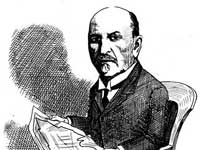Search | Image Archive | Reference | Communities | POV | Lesson Plans | Credits
 When the Titanic sailed from its last port of call it had 130 Canadians on board in “First Class”, with many others bound for new lives in Canada in “Third Class”. The two Canadian cities best represented were Canada’s then financial capital Montreal followed by Winnipeg, gateway to the West, and at the time in the midst of a huge real estate boom. Winnipeg had a trio of male friends on board who were traveling together. They included realtor Thomas Beattie, Union Bank president Thomas McCaffry, and John Hugo Ross, the son of the former Liberal-Conservative Member of Parliament for Lisgar, Manitoba, who had inherited the family real estate business. Also from Winnipeg was Edward Graham an Eaton’s employee returning from a buying trip in Europe. Often included in Winnipeg’s contingent is John James Borebank a real estate developer who had resided in the city, but at the time was living in Toronto.
When the Titanic sailed from its last port of call it had 130 Canadians on board in “First Class”, with many others bound for new lives in Canada in “Third Class”. The two Canadian cities best represented were Canada’s then financial capital Montreal followed by Winnipeg, gateway to the West, and at the time in the midst of a huge real estate boom. Winnipeg had a trio of male friends on board who were traveling together. They included realtor Thomas Beattie, Union Bank president Thomas McCaffry, and John Hugo Ross, the son of the former Liberal-Conservative Member of Parliament for Lisgar, Manitoba, who had inherited the family real estate business. Also from Winnipeg was Edward Graham an Eaton’s employee returning from a buying trip in Europe. Often included in Winnipeg’s contingent is John James Borebank a real estate developer who had resided in the city, but at the time was living in Toronto.
However, the most famous group of Winnipeggers on the Titanic was the Fortune family. Born in Ontario, Mark Fortune had made his mark in the real market, having purchased land along the Assiniboine River in the 1870s, which later became Portage Avenue, Winnipeg’ major thoroughfare. Mark became a man of substance, if not great wealth, and a pillar of the community—a trustee of Knox United Church, and a city councilor. In 1911, he built a 36 room Tudor-style mansion in one of Winnipeg’s exclusive neighborhoods. He had married Mary McDougald, a Portage woman, and together they had six children. Four of these were willing to go with their parents on a “Grand Tour” of Europe and the Mediterranean area in 1912. The young, athletic Charles was the only male child. His sisters included Ethel, soon to be married to a Toronto banker, the free spirited Mabel who was to elope with a jazz musician, and the active and carefree Alice. By all accounts the Fortune’s tour of Europe was a pleasant one, and they enjoyed visiting many of the tourist sites of Europe and the Near East, along with the trio of Winnipeg men. To cap off the trip the group bought tickets for the passage home for the maiden voyage of the largest ship then afloat, the RMS Titanic. The Fortunes occupied three “First Class” cabins: C-23, 25, and 27.
When the ship struck an iceberg on the night of 14 April 1912, Alice and Mabel entered Lifeboat #7, leaving their jewelry with Charles and their father, who apparently stuffed some of it into the pockets of his ragged buffalo coat. Ethel joined them, after returning to the cabin to look for her mother, when she was told Mary had already joined her two daughters. At this point most passengers believed it was far safer to be on the Titanic than in a tiny open rowboat, and so Lifeboat #7, the first to be launched, was actually not filled to capacity and contained more men (sixteen) than women (twelve). During the night the Fortune sisters helped row to the rescue ship Carpathia. They were to live the rest of their lives in Winnipeg, Toronto, Victoria, and London, England. All the Winnipeg men on the ship died.
A memorial plaque to these men was placed at City Hall, and now sits in the passageway between the old administration building and the new council chambers. It includes all their names but not that of Thomas McCaffry. McCaffry, along with two other Titanic crew members, was found dead of exposure, in an open boat, a month after the sinking.
See also: The Sinking of the SS Princess | The Winnitoba and the Bonnitoba | Manitoba’s Titanic Victims
This page was written by Brian Hubner.
Page revised: 12 November 2009